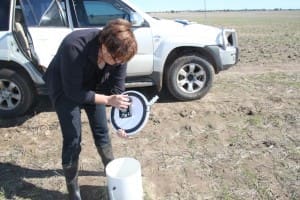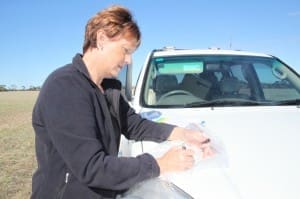How do you ensure trained people are readily available to take 7000 precision gas samples timed around seeding and rain events, on two farms 350km from the nearest research university?
Simple: you discover the hidden scientist in our farming women.
In addition to their skillsets of chief financial officer of their farm business, wife, mother, driver, livestock business co-manager and many other jobs, Western Australians Sharon Hinck and Jill Fotheringhame are performing this considerable, detailed task in their stride on their farms at Hyden and Karlgarin.
The WA Lot Feeders’ Association was a successful applicant for the Commonwealth Government Department of Agriculture’s Action on the Ground round 2 program, and has secured funding for a research project to look at building soil carbon in cropping systems and study the impact on greenhouse gas emissions using cattle feedlot compost.
The University of WA is providing the science leadership on the project, while Kerrigan Valley and Pederah Creek beef feedlots, owned by the Hinck and Fotheringhame families respectively, are hosting the trials, providing the compost and the technical labour required for the project.
The project will determine the benefits and impacts of applying compost, made from feedlot pen waste, to cropping systems. The work takes place over three years on 15 quarter-hectare plots on each farm, where combinations of compost, dry manure and urea/compound fertilisers have been applied and then seeded in a process that will be repeated for a further two seasons.
According to project manager and consultant to WALFA, Steve Jones of Bluesee, the project has two distinct components.
“The practical aspect that WALFA members want to understand is to have the cost benefit of on-farm compost production fully-analysed. They need to get a clear picture of the impact on yield from applying compost and if it is worth their time and money making it,” Mr Jones said.
“However at a much higher level, the project is an opportunity to get an on-ground understanding of the greenhouse gas issues connected to manure and compost, and this is where the technical services of two great farming women have come to the fore,” he said.
In April/May of each trial year, one of the project’s requirements is to undertake gas sampling for eight consecutive days after compost and manure application, and then conduct more testing after the first two major rain events (falls above 10mm).
“This is quite a technical process that has required specific training to undertake the work, but Jill and Sharon have taken this in their stride,” Mr Jones said.
“As it happened this year, the Hyden region got over 25mm of very welcome rain the day after the first lot of testing had finished, so in accordance with the testing protocol, the ladies had to fit in another seven days of testing without notice.”
 The gas samples are collected in custom-made collection chambers and then injected into vacuum-sealed vials before being shipped to the Queensland University of Technology where the gas analysis is undertaken.
The gas samples are collected in custom-made collection chambers and then injected into vacuum-sealed vials before being shipped to the Queensland University of Technology where the gas analysis is undertaken.
The project also involves measuring and quantifying methane and nitrous oxide emissions from the soils that have received the application of composts, compared to those that haven’t. For this component of the trial, a total of 270 soil samples will also be taken to measure carbon sequestration benefits and overall soil health.
Mr Jones paid tribute to UWA’s science team, who have designed a complex science project that links farm with science in such a way.
UWA has provided the gas sampling training to Jill and Sharon, who are performing all the soil sampling and analysis work.
“The real heroes of this trial are the two ladies who have agreed to become science technicians in the field,” Mr Jones said.
“The biggest challenge of designing this project was to find the science field labour so far from Perth. However we have demonstrated that with training, we can overcome that hurdle and generate a system that provides quality data collection for an important industry project,” Mr Jones said.
- The project is being funded by WA’s Department of Agriculture’s Action on the Ground program and managed on behalf of WALFA by Steve Jones of Bluesee. More information steve.jones@westnet.com.au

